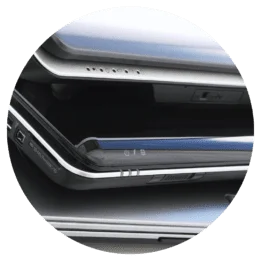Step 2: Source the devices
There are two main options for sourcing digital devices for upcycling: A) Use your own organisation’s retired devices and B) Request device donations from other organisations and individuals.
Option A: Upcycle your own organisation’s retired devices
Some organisations are able to source retired devices internally – typically as the result of a regular refresh/upgrade of IT equipment (e.g. every five years).
Key considerations
- How many devices do we currently have?
- How often do we refresh/upgrade our IT equipment?
- What types of devices are available for upcycling (e.g. laptops, smartphones, tablets)?
- What are the device specifications (e.g. model, make, year of manufacture)?
- What condition are the devices in (e.g. working order, parts missing, scratched/damaged, out-of-date software)?
- Where are the devices currently stored?
- Are the devices easily accessible at any time?
- Do we have a budget for upcycling these devices and what does it cover?
- Who will ultimately benefit from having these devices?
Top tips
- Conduct a detailed audit of the devices you have available for upcycling, including their type, specification and condition, to help you better understand the volume and quality of your stock.
- Consider who the beneficiaries of your upcycled devices will be as this can help inform the level of refurbishment required and your choice of upcycling service provider.
- For older devices (5 years +) and severely damaged devices (e.g. with broken hard drives), decide whether it makes better economic sense to recycle the device and use the funds generated to support upcycling or purchasing of new devices.
- If you decide to upcycle older devices (5 years +), consider whether there are additional cyber security risks (e.g. due to running unsupported operating systems) and explore options for applying free cyber security software.
Option B: Upcycle devices sourced from donors
Not all organisations have enough of their own retired devices to meet the needs of digitally excluded residents and may need to source devices from elsewhere. To address the high level of need during the COVID-19 pandemic, for example, several London boroughs worked with local businesses, community groups, charities and private sector organisations to source additional devices.
Key considerations
- What is the minimum threshold for the quality of devices we wish to accept?
- Do we need to have a transfer of ownership agreement between the donor organisation and our own organisation?
- What are the donor’s and our organisation’s needs for the delivery and storage of devices?
- Do we have secure storage facilities for large numbers of donated devices?
Top tips
- Engage with your Legal team as early as possible to understand your organisation’s position on what form of transfer of ownership agreement will be acceptable. It can take time to agree and sign a transfer of ownership agreement, especially if both the donor and recipient organisations have a long list of conditions and insist on using their own agreement templates. To help, you can adapt LOTI’s template transfer of ownership / gift agreement.
- If you plan to receive donated devices on your organisation’s premises, engage with your Facilities team early on to discuss secure storage and insurance.
- Consider whether it would be easier for donated devices to be sent directly to your upcycling service provider to avoid potential storage and insurance challenges.
- If the devices are to be transported from the donor organisation directly to your upcycling service provider, plan for the impact on the transfer of ownership and make decisions that satisfy everyone’s security requirements but that are also proportionate to the actual risk. You have three main options:
- Create two transfer of ownership agreements (one between your organisation and the donor organisation and another between your organisation and the upcycling service provider) and factor in time to get both agreements agreed and signed before receiving the devices
- Create one agreement between all three parties (your organisation, the donor organisation and the upcycling service provider) that clearly outlines everyone’s responsibilities
- Create a transfer of ownership agreement between the donor organisation and your upcycling service provider – this is the most effective way to manage the process

